Trees Birds Mammals Fish Amphibians Reptiles
Wild Algarve
Bookshop
Tricholoma acerbum (Bull.) Quél. - Bitter Knight
Phylum: Basidiomycota - Class: Agaricomycetes - Order: Agaricales - Family: Tricholomataceae
Distribution - Taxonomic History - Etymology - Identification - Culinary Notes - Reference Sources
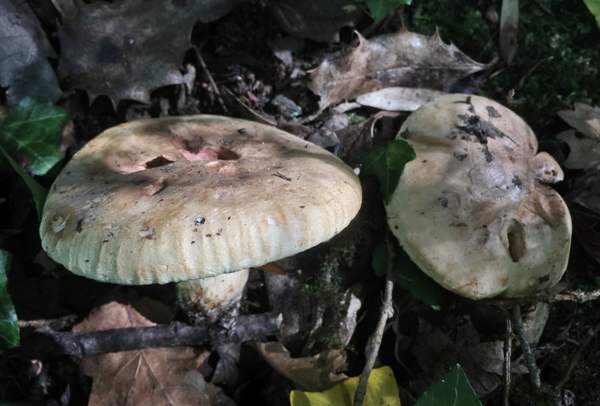
The Bitter Knight is one of the easiest of the Tricholoma species to identify in the field. Its large size and its pale ochre cap with and strongly inrolled margin are usually enough to convince anyone who has previously seen a few of these massive mushrooms.
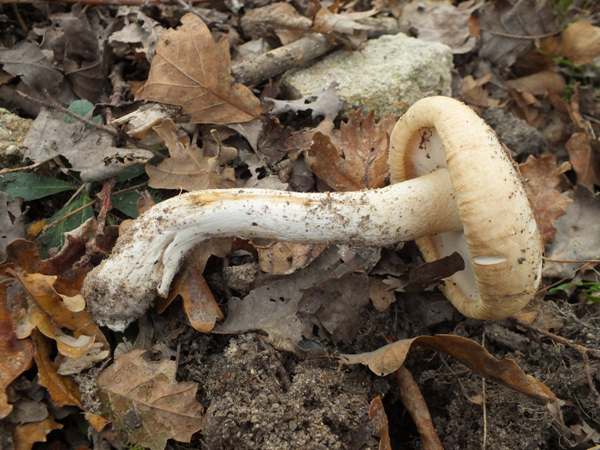
Distribution
This conspicuous 'knight' is a rare sight in Britain and Ireland; however in central and southern mainland Europe and in North Africa and parts of Asia, wherever there is oak or sweet chestnut woodland, there is always a cance of stumbling across a few of these huge mushrooms. This striking Tricholoma species has also been reported from parts of North America, but experts say that it is doubtful whether these finds are truly co-specific with the European Tricholoma acerbum.
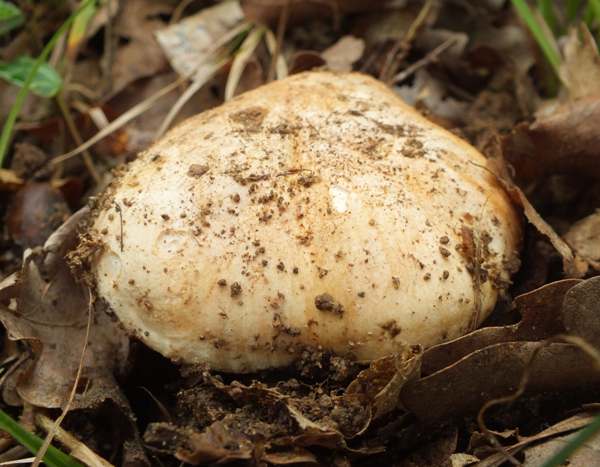
Taxonomic history
When Jean Baptiste Francois (Pierre) Bulliard described this woodland mushroom in 1792 he gave it the binomial scientific name Agaricus acerbus. (In the early days of fungus taxonomy most gilled fungi were placed into a gigantic Agaricus genus, since made more manageable by redistributing most of its contents to other new genera. The genus Agaricus now houses only the 'true mushrooms'.) Eighty years later, in 1872, French mycologist Lucien Quélet renamed this species Tricholoma acerbum, which is the name by which mycologists generally refer to it nowadays.
The only synonyms of Tricholoma acerbum that I am aware of are Agaricus acerbus Bull., and Gyrophilus acerba Quél.
Etymology
Tricholoma was established as a genus by the great Swedish mycologist Elias Magnus Fries. The generic name comes from Greek words meaning 'hairy fringe', and it must be one of the least appropriate mycological genus names, because very few species within this genus have hairy or even shaggily scaly cap margins that would justify the descriptive term.
The specific epithet acerbum means bitter, a reference to the taste of these chunky woodland mushrooms.
Identification guide
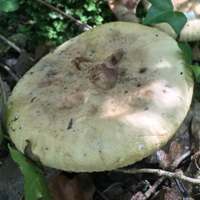 |
Cap
Initially hemispherical, later convex or flattened but retaining a pronounced inrolled margin; usually dry and smooth; mostly yellowish buff, but often light tan towards the centre when mature; surface mostly smooth but with a ribbed margin; 7 to 14cm across. |
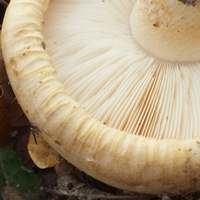
|
Gills
Creamy white or pale yellowish; eventually developing reddish brown spots; crowded.
Stem
White to pale yellowish-buff, pruinose towards the apex and with a slightly swollen or occasonally bulbous base; cylindrical, often curved near base; 4 to 12cm long, 1 to 2cm diameter; no stem ring. |
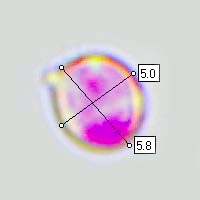 |
Spores
Broadly ellipsoidal or ovoid, smooth, 5-7 x 3.5-5μm; with a hilar appendage; inamyloid.
Spore print
White. |
Odour/taste |
Very slight fruity odour; taste usually sour (some say bitter and peppery). Note: this is reported to be a slightly poisonous species. |
Habitat & Ecological role |
Mycorrhizal, in calcareous broadleaf woodland, most often found under Quercus (oaks) and Sweet Chestnut trees. |
Season |
Usually July to October in Britain and Ireland, but if there are no heavy frosts then Bitter Knights can appear as late as November. |
Similar species |
Tricholoma roseocerba Riva is very similar in microscopic characteristics, but many authorities accept it as a separate species because of the pinkish tones in the cap surface. (T. roseacerba has not been recorded from Britain and Ireland.) |
Culinary Notes
The Bitter Knight is known to be slightly toxic and should not be collected for the pot. Even when thoroughly cooked these chunky mushrooms can cause gastric upsets if they are eaten.
Reference Sources
Fascinated by Fungi, 2nd Edition, Pat O'Reilly 2016, reprinted by Coch-y-bonddu Books in 2022.
Kibby, G (2013) The Genus Tricholoma in Britain, published by Geoffrey Kibby
Dictionary of the Fungi; Paul M. Kirk, Paul F. Cannon, David W. Minter and J. A. Stalpers; CABI, 2008
Taxonomic history and synonym information on these pages is drawn from many sources but in particular from the British Mycological Society's GB Checklist of Fungi.
Acknowledgements
This page includes pictures kindly contributed by Simon Harding.
Top of page...
Fascinated by Fungi. Back by popular demand, Pat O'Reilly's best-selling 450-page hardback book is available now. The latest second edition was republished with a sparkling new cover design in September 2022 by Coch-y-Bonddu Books. Full details and copies are available from the publisher's online bookshop...